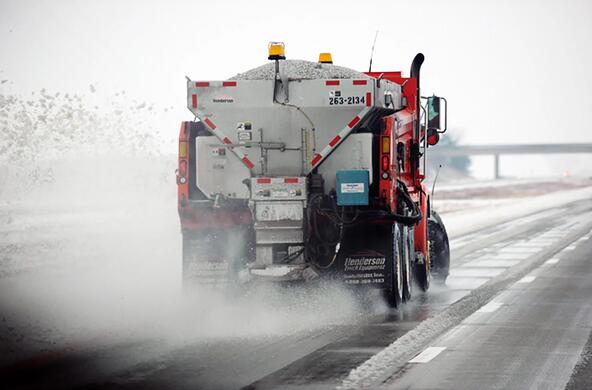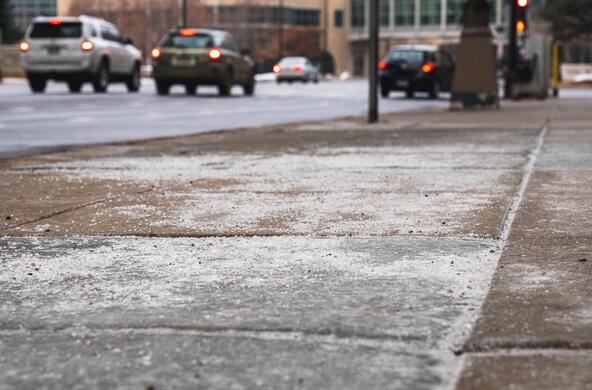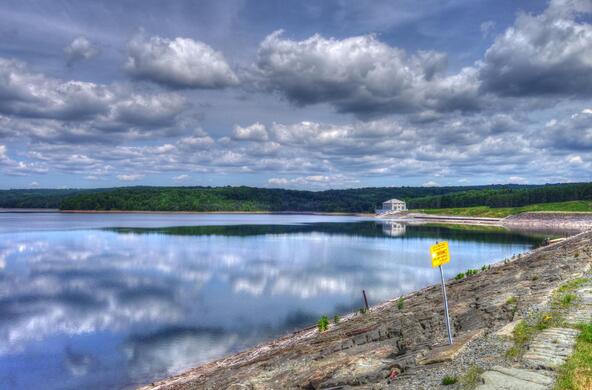In the 1940s, Americans found a new way to love salt. Not simply for sprinkling on food — we'd acquired a taste for the mineral long before that — but for spreading on roads and sidewalks. Salt became a go-to method to de-ice frozen pavement.
During the past half-century, annual U.S. sales of road salt grew from 160,000 tons to about 20 million tons, as a group of environmental scientists pointed out in a study published Monday in the Proceedings of the Natural Academy of the Sciences. NaCl kept roads free from slippery ice, but it also changed the nature of North America's freshwater lakes. Of 371 lakes reviewed in the new study, 44 percent showed signs of long-term salinization.
Extrapolating that finding for all of North America, at least 7,770 lakes are at risk of elevated salt levels — a likely underestimate, the researchers said.
Theirs is the first study of freshwater lakes on a continental scope. "No one has tried to understand the scale of this problem across the continent in the Northeast and Midwest, where people apply road salt," said study co-author Hilary Dugan, a University of Wisconsin-Madison freshwater expert.
No federal body tracks how much salt gets spread on our roadways or makes its way into our lakes. So the researchers hoovered up a vast number of different data sets, produced by states, municipalities and universities. The study was the product of several "big, nasty, hairy heterogeneous databases," as co-author Kathleen Weathers, an ecologist at the Cary Institute of Ecosystem Studies in New York, described it.
Each lake in the report had chloride measurements going back 10 years or more, was at least four hectares in size (about nine football fields or larger) and was in a state that regularly salted its roads during winter. The study authors also analyzed what percentage of the lake was surrounded by an impervious surface. This could be any combination of roadways, sidewalk pavement, boat launches or other hard surfaces.
Impervious surfaces, critically, allow dissolved salt to slide into lakes rather than soaking into soil. If at least 1 percent of the surface circling a lake was impervious, the lake was at risk of high chloride concentrations, the environmental scientists found.
Across all lakes, chloride concentrations ranged from 0.18 to 240 milligrams per liter, with a median of 6 milligrams per liter. (Seawater, by contrast, is much saltier — an average of about 35 grams per liter.) The Environmental Protection Agency recommends that salt in drinking water exceed no more than 250 milligrams per liter, at which point water tastes salty.
The scientists could not directly measure how much of the chloride came from road salt. But previous research indicated that agriculture, water softeners and other sources played only minimal roles. "Road salt is the major driver for chloride loading," Dugan said.
Environmental scientists had previously observed rising salt levels in the nation's rivers and streams. "These trends have been going on for decades," said Sujay Kaushal, an ecologist at the University of Maryland who was not involved in the new study. Kaushal has assessed freshwater streams that have wintertime salt concentrations up to 40 percent that of seawater. Saltwater plants now grow in some of these streams.
Lakes are generally less susceptible than streams to changes like salinization. They may also serve as sources of drinking water.
James P. Gibbs, a conservation biologist at the State University of New York who was not affiliated with the new research, said that combining the lake data sets must have amounted to a "herculean effort."
Gibbs has studied roadside pools and springs where amphibians lay their eggs and observed a "pretty high reduction in survival rates" of eggs and young in pools contaminated with road salt. Few amphibians live in large lakes, he noted. ("Lakes mean fish, and fish are bad news for amphibians.") But he and other environmentalists are concerned that exotic species, better suited for brackish water or tolerating chloride, will move into saltier lakes.
If current trends continue through 2050, 14 of the lakes studied would exceed the EPA's "aquatic life criterion concentration" of 230 milligrams per liter, the study authors predict. Another 47 would have a chloride concentration above 100 milligrams per liter.
"Right now it's about ecosystems and biota," Gibbs said, meaning animal and plant life. "It is kind of alarming. Ultimately, we're looking at a human health issue."
The average water treatment system will not remove dissolved elements like chloride ions from water. "You can't filter out these salts," Kaushal said.
Increased salt in drinking water poses health problems to humans who have kidney trouble, use dialysis or have hypertension. Kaushal has personal concerns about the matter, too — for his young child's health. He lives in an area where high salt levels were likely responsible for turning Montgomery County's drinking water brown in 2015, when, the theory goes, road salt stripped manganese from old pipes.
"I think it should be listed as a primary contaminant," just like potential pollutants such as nitrogen and phosphorous, he said. Changing our salty ways, though, may not be simple. "About 10 years ago, I was asked by a state senator in Maryland to testify on a road salt bill," he said. "And when he presented that, all of the other senators laughed at him."
Some municipalities have improved how they manage salt by tweaking the rate at which trucks dump salt on roads, for example. But signs point to an increased reliance on salt. In winter 2014, the Wall Street Journal reported that road salt prices surged by 20 percent due to a huge demand.
"We also are experiencing changes in the frequency and intensity of ice storms and snowstorms," Weathers said. "It's clearly a case where science can and should be used to help guide management decisions."
Even if we curb our enthusiasm for road salt, it will take some time for the environment to respond. In the latter half of the 20th century, Germany decreased the amount of road salt it used. But the country's lakes only recently began to show lower salinity levels. "There's a lag after stopping laying down salt — a lot of salt is stored in soils," Dugan said. "It's like a reservoir of salt."
Individual business and property owners are responsible, in some cases, for up to half of all road salt used, Dugan said.
For those caught between the need to keep their pavement safe and a desire to be environmentally conscious, Kaushal advised a more judicious approach. "People tend to think more is better, so they just dump or cake it on," he said. He recommends salting before a snow event. "That's going to be more effective."
And some states are exploring different de-icers — like beet juice or, in Wisconsin, liquid cheese brine, which is more efficient than just salt at low temperatures.







